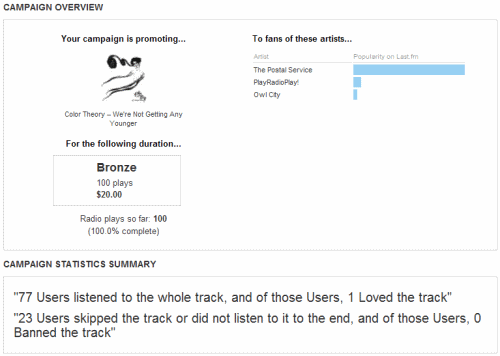In my previous post on Last.fm, I promised to follow up with the results of my Powerplay campaigns, which target a set number of radio plays to a particular group of users. Four packages are currently offered: $20 for 100 plays, $100 for 500 plays, $200 for 1,000 plays, and $400 for 2,000 plays. Since the per-play price is the same ($0.20), I opted for the cheapest.

I record electronic pop with hints of classical piano under the name Color Theory. To help determine my target demographic, I created three Powerplay campaigns, staggered over three weeks. The first was aimed at fans of The Postal Service (the electronic side project of Death Cab for Cutie frontman Ben Gibbard). I also included two indie electronic bands with young audiences: PlayRadioPlay! and Owl City. I chose my song “We’re Not Getting Any Younger,” which had already proven itself by winning #1 in the Electronic category at Ourstage.
Color Theory - We’re Not Getting Any Younger
Campaign #1 Results: The Postal Service, PlayRadioPlay!, Owl City
77 Users listened to the whole track, and of those Users, 1 Loved the track
23 Users skipped the track or did not listen to it to the end, and of those Users, 0 Banned the track
Next, I targeted the same song to fans of Depeche Mode, which tend to be closer to my age (or to put it in music industry terms, “old”).
Campaign #2 Results: Depeche Mode
68 Users listened to the whole track, and of those Users, 2 Loved the track
29 Users skipped the track or did not listen to it to the end, and of those Users, 0 Banned the track
Finally, I targeted “If It’s My Time to Go” to fans of Yazoo, who haven’t put out an album since 1983. The song was named Grand Prize Winner in the John Lennon Songwriting Contest, so I believe it’s at least as strong a track as “We’re Not Getting Any Younger.” Yazoo fans appear to disagree. One even banned the song.
Color Theory - If It’s My Time to Go
Campaign #3 Results: Yazoo
62 Users listened to the whole track, and of those Users, 2 Loved the track
38 Users skipped the track or did not listen to it to the end, and of those Users, 1 Banned the track
While the three sets of results aren’t dramatically different from each other, it’s probably safe to say that college kids are at least as enthusiastic about my music as their parents are. Still, would it be smarter to target my efforts at the generation of fans who still buy CDs? Since Last.fm users can stream almost anything for free, do they even pay for music anymore? Should I worry about selling at all, or position myself for a stream-on-demand future? You ask a lot of questions!
OK, so a Powerplay campaign can help you choose which songs to promote to which audiences, but will it generate more unpaid plays? Is there any hope of recouping the cost in sales down the line? Based on the numbers I’ve seen so far, the answer to both questions is no.

My new album was released in November, but didn’t reach iTunes until the end of the year. From the beginning of the year through the first campaign launch on March 2, I averaged 150 unique listeners per week. In the four weeks since, I averaged 225. 75 extra listeners per week times four weeks equals 300, which is exactly what the three campaigns paid for.
Factoring in other stats muddies the waters. Radio plays are up, but on-demand plays are down. Plays scrobbled is way up, but I’ve been consistently scrobbling the album overnight. What I can say for sure is this: I can’t trace a single sale, e-mail, or friend request on any network to my promotion efforts at Last.fm.
So is a Last.fm Powerplay campaign right for you? That depends. If you’re an established artist, paid promotion might not make a dent in your numbers. If you haven’t released anything yet, you should probably wait to launch the promotion as part of a broader effort. If you’ve got an album or two under your belt, but low numbers on the site, it might be worth paying to jump start the process. Still, you’ll get more bang-for-your buck at Jango, where you can buy radio plays at one-tenth the price. Details of my 5,000 play campaign coming soon!
Brian Hazard is a recording artist with fifteen years of experience promoting his seven Color Theory albums. His Passive Promotion blog emphasizes “set it and forget it” methods of music promotion. Brian is also the head mastering engineer and owner of Resonance Mastering in Huntington Beach, California.